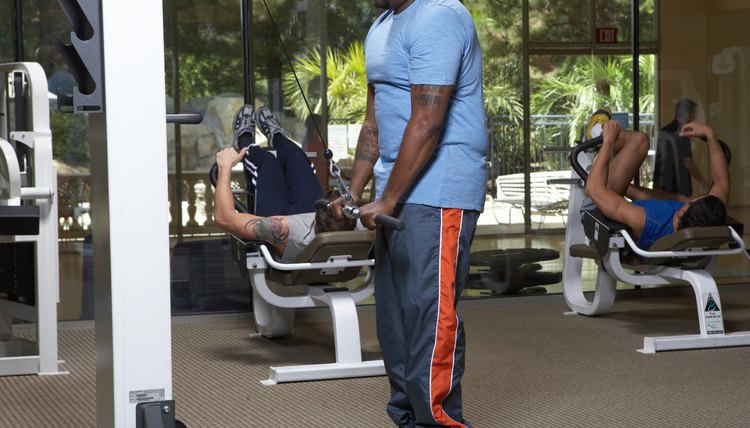What does fact checked mean?
At SportsRec, we strive to deliver objective content that is accurate and up-to-date. Our team periodically reviews articles in order to ensure content quality. The sources cited below consist of evidence from peer-reviewed journals, prominent medical organizations, academic associations, and government data.
The information contained on this site is for informational purposes only, and should not be used as a substitute for the advice of a professional health care provider. Please check with the appropriate physician regarding health questions and concerns. Although we strive to deliver accurate and up-to-date information, no guarantee to that effect is made.
How to Do a Standing Pulldown

If you’re looking for an exercise to help you develop both muscle width and thickness in your back, look no further than the standing pulldown. Typically performed on a cable machine with pulleys and a weight stack, pulldowns primarily target your latissimus dorsi, one of the largest muscles in your back. Several assisting muscles such as your pecs, triceps, deltoids and rhomboids are also worked, and with a slight change in execution, you can also involve your biceps.
Set up the cable machine with the correct amount of resistance. Choose a weight appropriate to your skill and strength level and then insert the pin into the weight stack. A good guideline to follow is to use a weight that allows you to perform eight to 12 reps before your form breaks down.
Attach a straight bar to the high-pulley cable. Face the machine and stand with your feet shoulder-width apart. Extend your arms and reach up to grasp the bar with an overhand grip. Slide your hands apart until they are shoulder-width apart.
Step back away from the machine, 1 or 2 feet, just enough to lift the weight stack an inch. This ensures a constant tension on your muscles. While keeping your arms straight, pull the bar down until your arms are parallel to the floor and keep a slight bend in your knees. This is the starting position.
Lean forward slightly at your waist as you start the downward pull. Exhale, keep your arms straight, eyes focused straight ahead and pull the bar down until it reaches your thighs. Squeeze your lats at the bottom of the pull.
Pause for a count of two, inhale and reverse your movement in a controlled motion. Stop when you are back at the starting position -- arms parallel to the floor -- and then repeat. Perform two to three sets of eight to 12 reps.
Alter your technique slightly if you want to engage your biceps. Start by holding the bar with your arms extended higher than your head, bending your hips and knees and moving your butt backward as if you're about to sit on a chair. Exhale, bend your elbows and pull the bar toward your chest. Inhale, reverse your movement and repeat.
Tips
Avoid moving your upper body back and forth to gain momentum between reps. Increase the stretch of your lats by leaning forward a little more and starting with the bar higher than your shoulders.
Warnings
Perform a short, 10-minute warm-up consisting of activities such as jogging, jumping rope or cycling to prepare your muscles and avoid injury. If you are new to exercising, get the OK from your doctor before starting a new fitness regimen.
References
Tips
- Avoid moving your upper body back and forth to gain momentum between reps.
- Increase the stretch of your lats by leaning forward a little more and starting with the bar higher than your shoulders.
Warnings
- Perform a short, 10-minute warm-up consisting of activities such as jogging, jumping rope or cycling to prepare your muscles and avoid injury.
- If you are new to exercising, get the OK from your doctor before starting a new fitness regimen.
